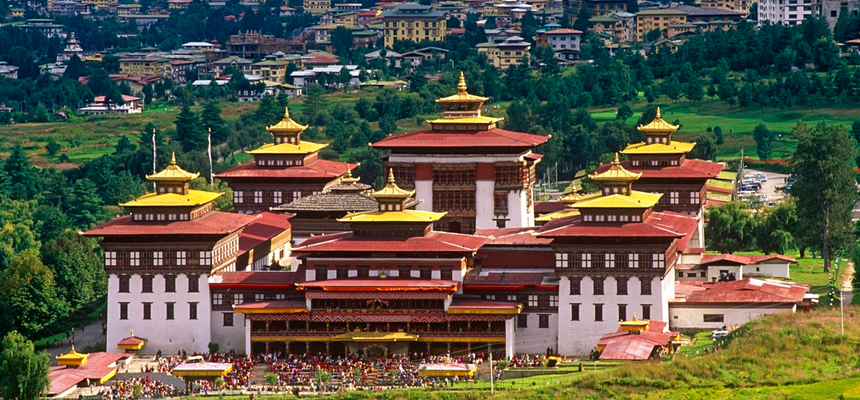The modern capital of Bhutan lies at an elevation of 2300m in a valley traversed by the Wang chu (river). Trashi Chho Dzong the main Secretariat building which houses the throne room of His Majesty and a summer residence of the central monk body. Although not what one expects from a capital city, Thimpu is a fitting and lively place. Home to civil servants, expatriates and the monk body, Thimpu maintains a strong national character in its architectural style. It is also an ideal spot for day walks. Phajoding monastery is a 4hrs hike from the motithang area; Tango & Cheri monasteries are also another 3/4hrs hike from the capital or all the way to the top of telegraph hill where thousands of prayer flags obscure the view over Thimpu.
Sightseeing around Thimpu
The Memorial Chorten
This stupa was built in 1974 in the memory of the late third King Jigme Dorji Wangchuk. The paintings and images inside the monument provide a rare sight into Buddhist philosophy.
Changlimithang Weekly Market
Every Saturday & Sunday most of the Thimpu’s population and many valley dwellers congregate on the banks of the river where the weekend market is held. This is the only time in the week when fresh vegetables are available and Saturday mornings are a hive of activity.
Trashi Chho Dzong
Tashichho Dzong was initially built in the 17th century, was rebuilt in early 1960s by the third King. Tashichho Dzong houses the main Secretariat building and the central monk body. It is open to visitors during Thimphu festival and when the monk body moves to their winter home in Punakha.
School of Arts and Crafts Royal Academy of Performing Arts
Where young children learn the ancient art of paintings. One can actually see students at work. Education is free for the students since the Government wants to attract more students. These children after passing out they are distributed to different districts to apply the same art of traditional paintings in these areas which is one reason that the Bhutanese houses have almost the same type of colour & design.
National Library
The history of Bhutan lies imprinted in archaic texts which are preserved at the National library. Besides thousands of manuscripts and ancient texts the library also has modern academic books and printing blocks for prayer flags.
Zoo
Above the way to BBS tower, stop by to see a large fenced area that was originally established as a mini zoo. The king decided that such a facility was not keeping with Bhutan’s environmental and religious convictions, and it was disbanded sometime ago. The animals were released into the wild but the taking were so tame that they wandered around the streets of Thimphu looking for food, and the only solution was to put them back into captivity.
Changangkha Lhakhang
Changangkha temple built in the 15 century by lama Phajo Drigom lies on a hill top commanding the Thimphu valley. The temple has very old scriptures and Thankhas. The main deity of the temple is Avalokiteshvara, God of compassion.
Indigenous hospital
Since Bhutan has its own brand of Himalayan medicine the Government has given equal emphasis to both allopathic and traditional medicines. The rich herbal medicine is prepared here. The old art healing like acupuncture is still practiced.
Simtokha Dzong
Simtokha is about 5km south of Thimpu on the road to Paro and Phuentsholing. Officially known as “Sangkak Zabdhon Phodrang” (Palace of the Profound Meaning of Secret Mantras), Simtokha Dzong was built in 1629 by Shabdrung Ngawang Namgyal. It is often said to be the first dzong built in Bhutan. It is the oldest dzong that has survived as a complete structure, and is the first structure that incorporated both monastic and administrative facilities. Since 1961 it has been the home of a rigney (religious and classical studies) school. Its students are both monks and lay people. The site is said to have been chosen to guard over a demon that had vanished into the rock nearby, hence the name Simtokha from sinmo (demoness), do (stone). Conveniently, the site is also an excellent location from which to protect the Thimphu valley and the valley leading to the Dochula and eastern Bhutan.
Drub hob Goemba
Dechencholing Palace
Pangri Zampa Temple
Tango Goemba
Chari Goemba


Comments